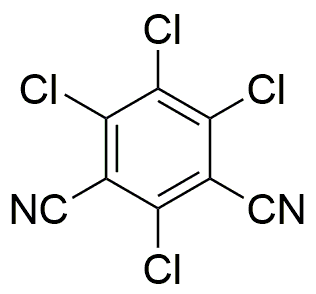Tetrachloroisophthalonitrile is widely utilized in research focused on:
- Polymer Production: It serves as a key intermediate in the synthesis of high-performance polymers, particularly in the production of polyimides, which are known for their thermal stability and chemical resistance.
- Flame Retardants: This compound is incorporated into materials to enhance their flame-retardant properties, making it valuable in industries such as electronics and construction where fire safety is crucial.
- Agricultural Chemicals: It is used in the formulation of pesticides and herbicides, providing effective solutions for crop protection while minimizing environmental impact.
- Analytical Chemistry: The compound is employed in various analytical techniques, including chromatography, to separate and identify complex mixtures, aiding researchers in material characterization.
- Textile Industry: It is applied in the treatment of fabrics to improve their durability and resistance to environmental factors, enhancing the longevity of textiles.
General Information
Properties
Safety and Regulations
Applications
Tetrachloroisophthalonitrile is widely utilized in research focused on:
- Polymer Production: It serves as a key intermediate in the synthesis of high-performance polymers, particularly in the production of polyimides, which are known for their thermal stability and chemical resistance.
- Flame Retardants: This compound is incorporated into materials to enhance their flame-retardant properties, making it valuable in industries such as electronics and construction where fire safety is crucial.
- Agricultural Chemicals: It is used in the formulation of pesticides and herbicides, providing effective solutions for crop protection while minimizing environmental impact.
- Analytical Chemistry: The compound is employed in various analytical techniques, including chromatography, to separate and identify complex mixtures, aiding researchers in material characterization.
- Textile Industry: It is applied in the treatment of fabrics to improve their durability and resistance to environmental factors, enhancing the longevity of textiles.
Documents
Safety Data Sheets (SDS)
The SDS provides comprehensive safety information on handling, storage, and disposal of the product.
Product Specification (PS)
The PS provides a comprehensive breakdown of the product’s properties, including chemical composition, physical state, purity, and storage requirements. It also details acceptable quality ranges and the product's intended applications.
Certificates of Analysis (COA)
Search for Certificates of Analysis (COA) by entering the products Lot Number. Lot and Batch Numbers can be found on a product’s label following the words ‘Lot’ or ‘Batch’.
*Catalog Number
*Lot Number
Certificates Of Origin (COO)
This COO confirms the country where the product was manufactured, and also details the materials and components used in it and whether it is derived from natural, synthetic, or other specific sources. This certificate may be required for customs, trade, and regulatory compliance.
*Catalog Number
*Lot Number
Safety Data Sheets (SDS)
The SDS provides comprehensive safety information on handling, storage, and disposal of the product.
DownloadProduct Specification (PS)
The PS provides a comprehensive breakdown of the product’s properties, including chemical composition, physical state, purity, and storage requirements. It also details acceptable quality ranges and the product's intended applications.
DownloadCertificates of Analysis (COA)
Search for Certificates of Analysis (COA) by entering the products Lot Number. Lot and Batch Numbers can be found on a product’s label following the words ‘Lot’ or ‘Batch’.
*Catalog Number
*Lot Number
Certificates Of Origin (COO)
This COO confirms the country where the product was manufactured, and also details the materials and components used in it and whether it is derived from natural, synthetic, or other specific sources. This certificate may be required for customs, trade, and regulatory compliance.


